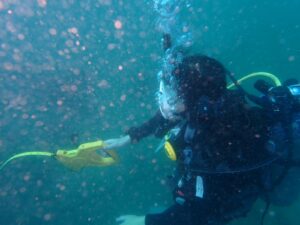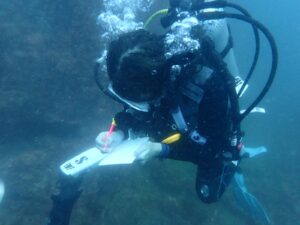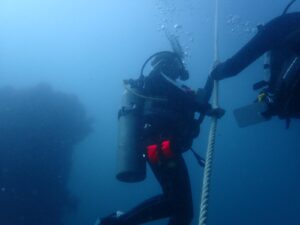Each dive SCUBAnauts conducts has a research or education mission. Recently, some members from the Savannah Chapter took a trip up to Myrtle Beach to dive the Sherman Wreck and practice archeology techniques as well as fish identification.
ENTRY:
One thing that was very different for me was the entry. Our boat required a back roll off the side of the boat to enter the water. None of the nauts that went had done this entry before and we were definitely nervous. The only time we practiced that was from a pool edge into the water, but the drop into the ocean was way higher.
The crew gave us instructions such as holding your mask and regulator with one hand, and the back of your head with the other. Also to keep your knees together and inflate BCD before entering. A lot of us were concerned that we would hit our head on the back of the tank, but once we just went for it, that wasn’t the case. I actually enjoyed the entry a lot because it was very fun.
DIVE 1:
On the first dive our mission was to measure a few dimensions along the wreck. We split up into two groups in order to collect the most data. One group measured the bow, while the other focused on the stern. Our goal was to see how close we could get to the real dimensions. The visibility was between 20 and 30 ft. The ship was deteriorated to where the beams and the shaft were exposed. We measured the width of the hull which was around 23 ft and then the circumference of the smokestack was 21 ft. The ship was 55 ft down but the smokestacks started at 30 ft.
DIVE 2:
The second dive that day focused on fish ID at the wreck. We stayed in the same groups but switched sides of the ship. We saw oyster toad fish, a barracuda, flounders, a sting ray, and schools of round scad just to name a few. The visibility on this dive wasn’t as good as the first dive, but it did not interfere with our ability to see the fish.
MY EXPERIENCE:
I really enjoyed the descent of the dive because we held onto a guide rope and followed it down. Then there was a thin cross rope that we followed to get across the ship . I found that this made it easy to navigate the wreck and to stay with the group. It also helped with safety stop because you held onto the rope and didn’t have to worry about buoyancy.
One thing I learned about myself was that I enjoy this type of dive rather than a drift dive. For me it’s easier to get lost from the group in a drift dive because as soon as you jump in the water, you have to get down quickly. Otherwise it was easy to lose the group. Being able to use the rope made it easier to stick together, especially when I have to equalize my ears. Overall, I really enjoyed this type of dive.
— Alaina B., 2nd Class Naut, Savannah Chapter




